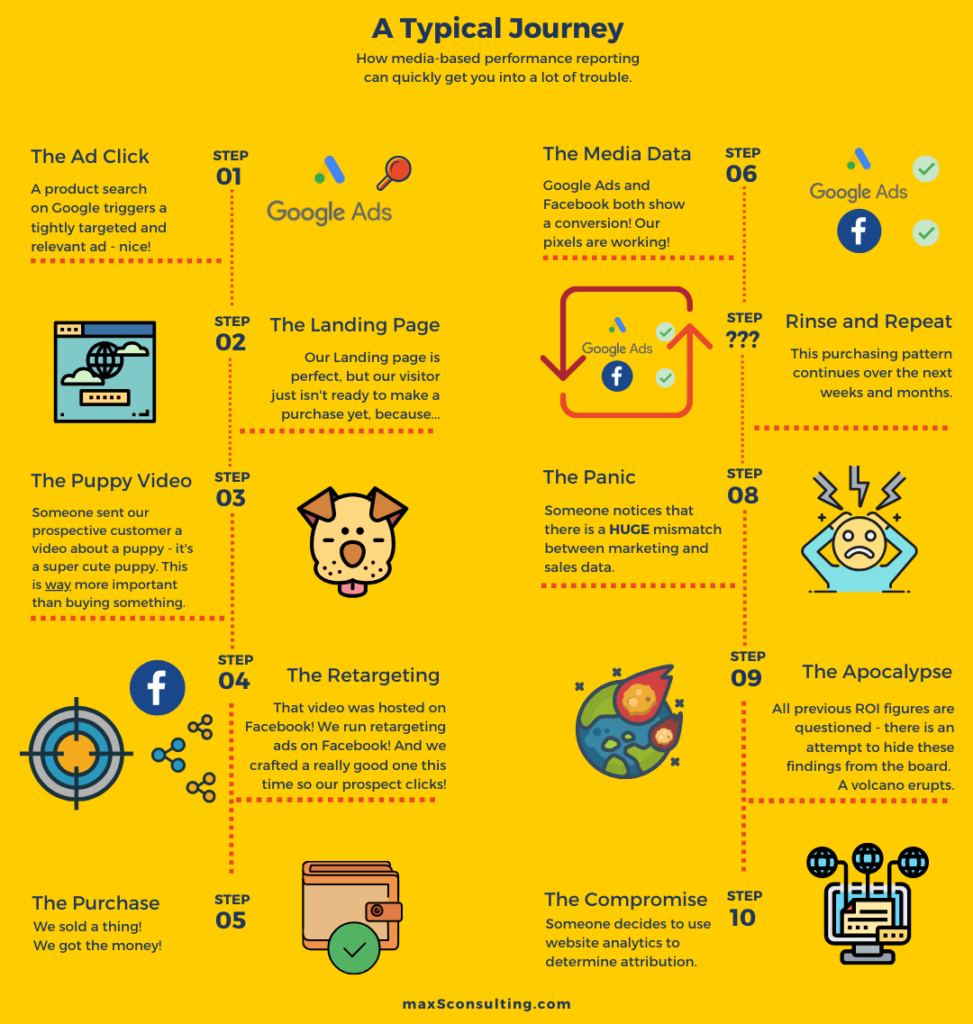”Help! My media agency is telling me that they’ve generated 10 ‘conversions’ but I only see 3 in my system – what’s going on!?”
– Everyone that has ever hired a media agency.
Defining what “success” means is a hairy problem for brands and advertisers – what does it mean to generate a “conversion”? How well does that align with how an organization actually measures business success?
And why the hell is the marketing department or media agency reporting on a set of metrics that have nothing to do with what ROI actually means for our business?
Let’s imagine the following, not so hypothetical scenario: your media agency or marketing team placed a number of pixels on various landing pages.
You’re reasonably certain that these pixels are measuring interactions on your website that closely align with how you think about success as a business (that topic, and defining what exactly a ‘conversion’ means is something we’ll be discussing in a separate write-up).
You’re all set to measure the effectiveness of your advertising initiatives, right? Maybe.
Here is an illustrated summary of what’s likely to follow (click to enlarge):
So what’s really going on here? How can it be the case that Facebook and Google (and our media agency…) claim more conversions than we actually see in reality? Where are the missing transactions? How much revenue are we actually generating?
The answer is simple: Trust your sales data. TRUST YOUR SALES DATA.
Ad Platforms Don’t Talk to Each Other
Ad platforms only know about the clicks that occur on their own platforms. They don’t talk to each other. More importantly: these platforms have a vested interest in not talking to each other – they all want to claim the credit and charge you for the ad click (or purchase)!
Let’s take a look at how an ad platform actually tracks your conversion:
- When an ad is served to you, this ‘impression‘ along with other metadata is saved to a cookie that is unique to your browser.
- When you click the ad, this interaction is stored as well.
- When you complete a purchase or other conversion, that information is sent to the advertiser together with your previous interactions (or sometimes as a unique ID, that is later tied to your previous interactions on the advertiser side of things).
- The advertiser will attribute that conversion typically to the day of the ad click.
See the problem yet? When ads are served and clicked across multiple advertisers prior to a conversion, each of those advertisers will claim credit for the same conversion.
Takeaway: If you (or your media agency) are reporting on conversions based solely on media data, in all likely-hood you are double, or even triple, counting conversions!
Website Analytics to the Rescue
As a whole, this area of digital analytics is most commonly referred to as ‘attribution‘. “Solving” attribution is a big topic that goes beyond the scope of this article – but my purpose here is to get you to agree to one thing: website analytics is the starting point for measuring digital marketing performance.
How’s that? Website analytics sits (unsurprisingly) on your website, and measures the comings, goings, and various interactions that occur there.
The most important point here is that your website analytics platform is going to know which media platform (or campaign, or ad) was the most recent touch-point (also called ‘last-click’) prior to an actual purchase on your website.
This means the analytics platform is able to attribute the conversion to just a single interaction, thereby avoiding the double-counting problem we outlined earlier.
Does that mean you should only ever look at your website analytics data to determine advertising effectiveness? No. Your website analytics platform won’t know how many impressions you served, how much you spent to generate a click, or what your effective reach and engagement was for a given advertising campaign (with some notable exceptions, such as the Google Ads / Google Analytics integration).
(And it bears repeating: business success is ultimately measured in your actual transaction or CRM platform – trust your sales data above all).
Takeaway: Use website analytics to determine which advertising initiative should get the last-click credit for generating conversions.
Okay, enough generic talk – what actual platform am I recommending here? If you’re just starting out, I highly recommend the free version of Google Analytics – it’s robust, fairly intuitive, and has some significant benefits if you’re considering advertising on Google Ads.
How should you actually set up and think about measuring conversions in Google Analytics? Great question – we’ll be covering that next!

